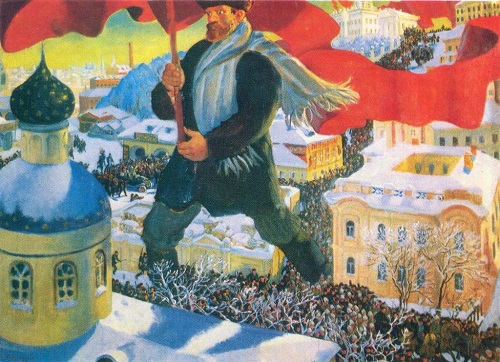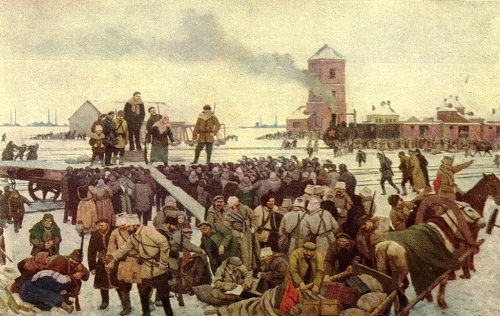Great October Revolution in painting

Great October Revolution in painting. Konstantin Yuon (1875-1958). The new planet. Tempera. 1921. The State Tretyakov Gallery
Great October Revolution in painting
Soviet Revolution inspired artists to create outstanding works of painting and sculpture. They help us to understand better and feel stronger national character and greatness of the October Revolution. The dream of people of socialism, for which the October Revolution was accomplished, the artist Konstantin Yuon expressed in the painting “The new planet.” We see on the alarming dark sky cut with the bright rays of light, sunrise of a huge red planet symbolizing socialism. The inhabitants of the earth aspire to it, holding out their hands as if praying for happiness. Their way is not easy. Some died, others are in confusion, fear – this new world is not for them. But the majority of people welcome the birth of a new planet. This planet is red because the new society is born in a brutal fight, because the red – a symbol of the revolution.

Great October Revolution in painting. O. Savostyuk, B. Uspensky. Revolutionary keep step. The left part of the triptych. Poster. 1967 All-Russian exhibition “The Artist and Time” dedicated to the 70th anniversary of the Great October Revolution

Great October Revolution in painting. Boris Kustodiev. February 27, 1917. Oil. 1917. The State Tretyakov Gallery
At the beginning of 1917 in Russia won the February Revolution, which overthrew the power of the king. The first artist to reflect it in the work, was Boris Kustodiev. He called his picture “27 February 1917”, because on this day the insurgent workers and soldiers seized Petrograd, were created the Soviets of Workers ‘and Soldiers’ Deputies and the Provisional Committee of the State Duma, then formed the bourgeois Provisional Government.

Great October Revolution in painting. Boris Kustodiev. Bolshevik. Oil. 1920. The State Tretyakov Gallery
Kustodiev was then seriously ill and could not go out. But he watched the scene in the city from the window of his apartment and immediately began to paint. After the victory of the revolution in Petrograd Soviets began to take power in other cities. Lenin called it “victorious triumphal march of Bolshevism all over this vast country.” This triumphal march of the Bolsheviks is depicted in the painting by Boris Kustodiev “Bolshevik.” A worker, walking with the red flag in his hands, recalls the legendary leaders of popular revolts. He’s on the way the church. Previously, there was nothing above it. But the Bolsheviks became above the church and the rich palaces. He overcomes all obstacles standing in the way. He goes to a new life and leads the people.
Proletarian Revolution and the Civil War in Russia are closely connected with each other. All this is reflected in art, which is characterized by expressive, coloristic expressiveness, sharp picture and dynamic composition in the image of revolution and civil war heroes.
Great October Revolution in painting

AP Tkachev (b. 1922), SP Tkachev (b. 1925) Between battles. 1960 oil on canvas. The State Tretyakov Gallery

Boris Ioganson (1893 – 1973). Interrogation of Communists. 1933. Oil on canvas. State Tretyakov Gallery

DP Dmitriev (1925-1980). ‘… And at the Pacific Ocean They have ended their campaign’. From the series ‘Songs of the Civil War ‘

GK Savitsky (1887-1949). Military campaign of Taman Army in 1918. 1938. Oil on canvas. Central Museum of the Armed Forces

GM Korzhev (b. 1925) Communists. Triptych 1958-1960. Raising the banner. The central part of the triptych. Canvas, oil

IA Zarinsh (1929-1998). Speech. (Central part of the triptych ‘Soldiers of the Revolution’). 1965. Oil on canvas

KF Yuon (1875-1958). Seeing the working unit to the front. 1928. Oil on canvas. Central Museum of the Armed Forces

Kuzma Petrov-Vodkin (1878-1939). Death of Commissar. 1928. Oil on canvas. The State Russian Museum. Leningrad

MB Grekov (1882-1934). Trumpeters of the First Cavalry. 1934. Oil on canvas. State Tretyakov Gallery

MI Samsonov (1925 -2013), MA Ananiev (b. 1925), VP Feldman (1924-1961). Sturm of Perekop in 1920. Diorama. Fragment. 1952-1962. Central Museum of the Armed Forces

R. R. Frents (1886-1956). SM Kirov in the North Caucasus organizes the First Cavalry Regiment in 1918. 1937. Oil on canvas. Central Museum of the Armed Forces of the USSR



























